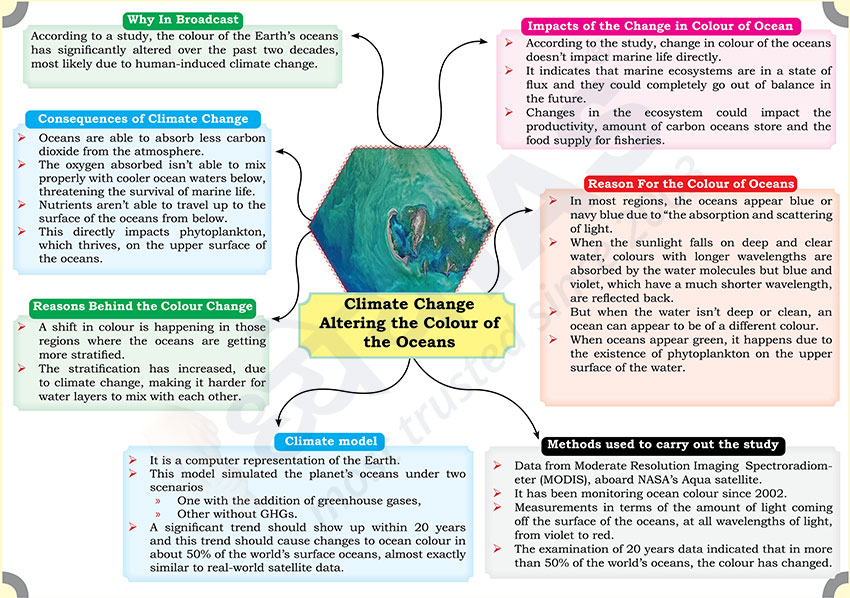Brain-booster
/
24 Aug 2023
Brain Booster for UPSC & State PCS Examination (Topic: Climate Change Altering the Colour of the Oceans)

Why in Broadcast?
- According to a study, the colour of the Earth’s oceans has significantly
altered over the past two decades, most likely due to human-induced climate
change.
Impacts of the Change in Colour of Ocean
- According to the study, change in colour of the oceans doesn’t impact
marine life directly.
- It indicates that marine ecosystems are in a state of flux and they
could completely go out of balance in the future.
- Changes in the ecosystem could impact the productivity, amount of carbon
oceans store and the food supply for fisheries.
Reason For the Colour of Oceans
- In most regions, the oceans appear blue or navy blue due to “the
absorption and scattering of light.
- When the sunlight falls on deep and clear water, colours with longer
wavelengths are absorbed by the water molecules but blue and violet, which
have a much shorter wavelength, are reflected back.
- But when the water isn’t deep or clean, an ocean can appear to be of a
different colour.
- When oceans appear green, it happens due to the existence of
phytoplankton on the upper surface of the water.
Methods used to carry out the study
- Data from Moderate Resolution Imaging Spectroradiometer (MODIS), aboard
NASA’s Aqua satellite.
- It has been monitoring ocean colour since 2002.
- Measurements in terms of the amount of light coming off the surface of
the oceans, at all wavelengths of light, from violet to red.
- The examination of 20 years data indicated that in more than 50% of the
world’s oceans, the colour has changed.
Climate model
- It is a computer representation of the Earth.
- This model simulated the planet’s oceans under two scenarios
- One with the addition of greenhouse gases,
- Other without GHGs.
- A significant trend should show up within 20 years and this trend should
cause changes to ocean colour in about 50% of the world’s surface oceans,
almost exactly similar to real-world satellite data.
Reasons Behind the Colour Change
- A shift in colour is happening in those regions where the oceans are
getting more stratified.
- The stratification has increased, due to climate change, making it
harder for water layers to mix with each other.
Consequences of Climate Change
- Oceans are able to absorb less carbon dioxide from the atmosphere.
- The oxygen absorbed isn’t able to mix properly with cooler ocean waters
below, threatening the survival of marine life.
- Nutrients aren’t able to travel up to the surface of the oceans from
below.
- This directly impacts phytoplankton, which thrives, on the upper surface
of the oceans.







